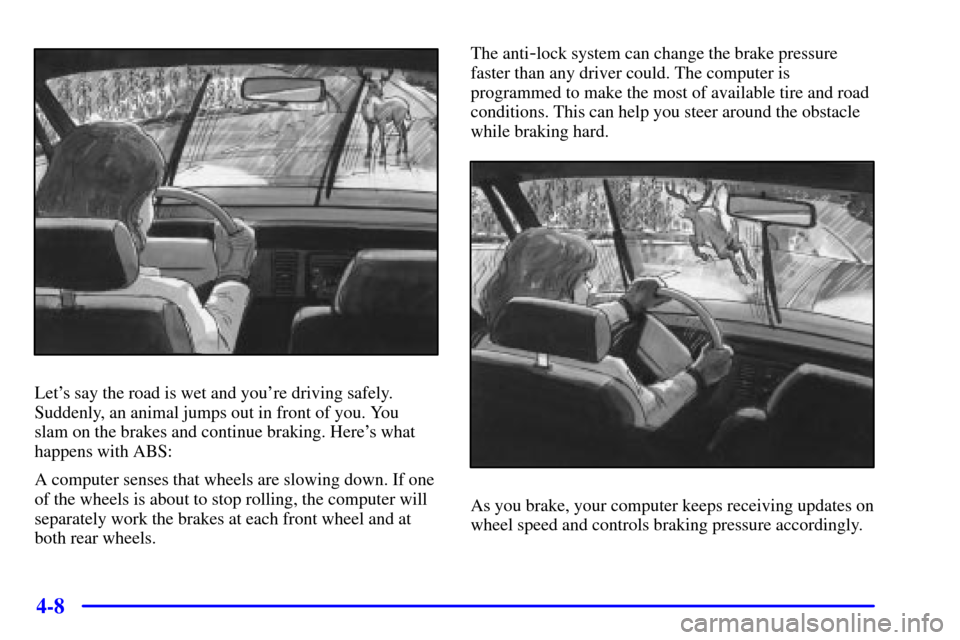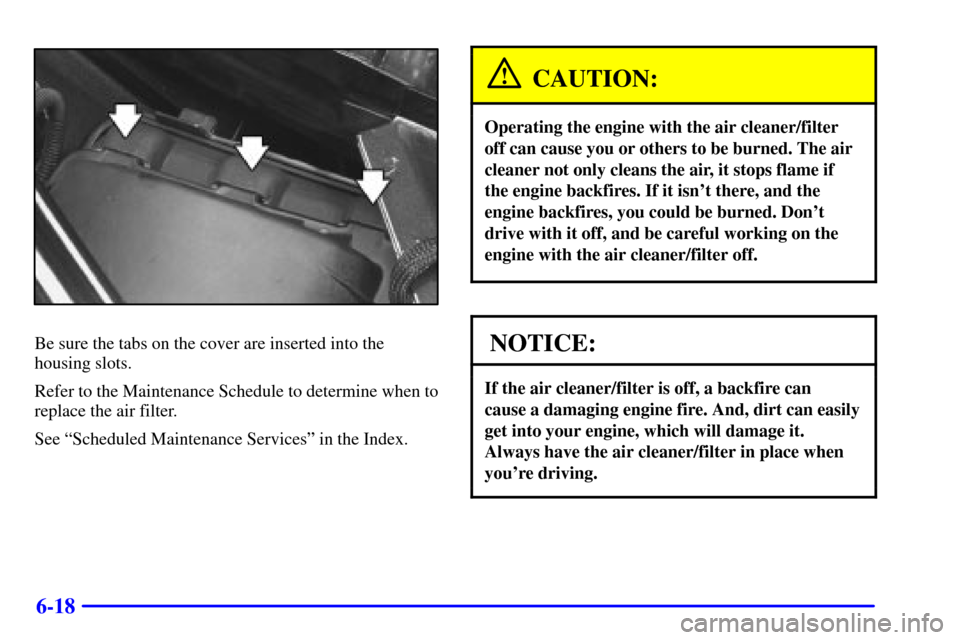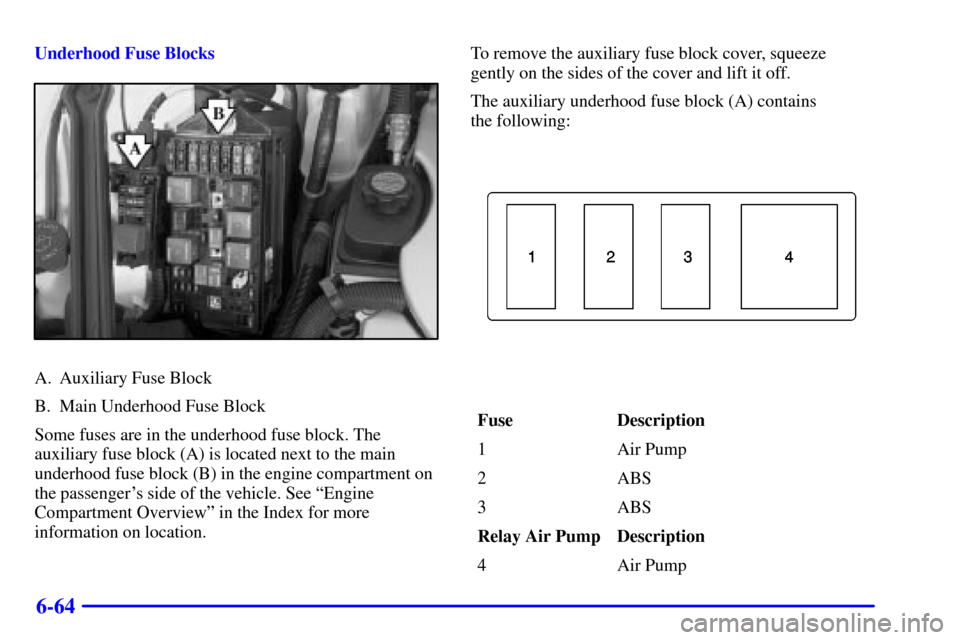ABS Oldsmobile Intrigue 2002 Owner's Manuals
[x] Cancel search | Manufacturer: OLDSMOBILE, Model Year: 2002, Model line: Intrigue, Model: Oldsmobile Intrigue 2002Pages: 363, PDF Size: 2.53 MB
Page 12 of 363

1-6 Head Restraints
Slide the head restraint up or down so that the top of the
restraint is closest to the top of your head. This position
reduces the chance of a neck injury in a crash.
Split Folding Rear Seat (If Equipped)
This feature enables you to have direct access to the
trunk from the rear seat of the vehicle. The tabs to pull
the split folding rear seat down are located on the
outboard sides of the rear seatback.
To fold down the rear
seatback, pull the seat
tab latch forward.
To return the seat to its original position, push it back up
and make sure it latches in the locked position by
pulling and pushing on the seatback.
Page 190 of 363

4-7
Avoid needless heavy braking. Some people drive in
spurts
-- heavy acceleration followed by heavy
braking
-- rather than keeping pace with traffic. This is a
mistake. Your brakes may not have time to cool between
hard stops. Your brakes will wear out much faster if you
do a lot of heavy braking. If you keep pace with the
traffic and allow realistic following distances, you will
eliminate a lot of unnecessary braking. That means
better braking and longer brake life.
If your engine ever stops while you're driving, brake
normally but don't pump your brakes. If you do, the
pedal may get harder to push down. If your engine
stops, you will still have some power brake assist. But
you will use it when you brake. Once the power assist is
used up, it may take longer to stop and the brake pedal
will be harder to push.
Anti-Lock Brake System (ABS)
Your vehicle has anti-lock brakes. ABS is an advanced
electronic braking system that will help prevent a
braking skid.
When you start your engine, or when you begin to drive
away, your anti
-lock brake system will check itself. You
may hear a momentary motor or clicking noise while
this test is going on, and you may even notice that your
brake pedal moves or pulses a little. This is normal.
United States Canada
If there's a problem with the anti
-lock brake system, this
warning light will stay on. See ªAnti
-Lock Brake
System Warning Lightº in the Index.
Page 191 of 363

4-8
Let's say the road is wet and you're driving safely.
Suddenly, an animal jumps out in front of you. You
slam on the brakes and continue braking. Here's what
happens with ABS:
A computer senses that wheels are slowing down. If one
of the wheels is about to stop rolling, the computer will
separately work the brakes at each front wheel and at
both rear wheels.The anti
-lock system can change the brake pressure
faster than any driver could. The computer is
programmed to make the most of available tire and road
conditions. This can help you steer around the obstacle
while braking hard.
As you brake, your computer keeps receiving updates on
wheel speed and controls braking pressure accordingly.
Page 200 of 363

4-17
While driving on a surface with reduced traction, try
your best to avoid sudden steering, acceleration or
braking (including engine braking by shifting to a lower
gear). Any sudden changes could cause the tires to slide.
You may not realize the surface is slippery until your
vehicle is skidding. Learn to recognize warning
clues
-- such as enough water, ice or packed snow on
the road to make a ªmirrored surfaceº
-- and slow
down when you have any doubt.
Remember: Any anti
-lock brake system (ABS) helps
avoid only the braking skid.
Driving at Night
Night driving is more dangerous than day driving.
One reason is that some drivers are likely to be
impaired
-- by alcohol or drugs, with night vision
problems, or by fatigue.
Page 225 of 363

4-42 Driving On Grades
Reduce speed and shift to a lower gear before you start
down a long or steep downgrade. If you don't shift
down, you might have to use your brakes so much that
they would get hot and no longer work well.
On a long uphill grade, shift down and reduce your
speed to around 45 mph (70 km/h) to reduce the
possibility of engine and transaxle overheating.
If you have overdrive, you may have to drive in
THIRD (3) instead of AUTOMATIC OVERDRIVE (D).
Parking on Hills
CAUTION:
You really should not park your vehicle, with a
trailer attached, on a hill. If something goes
wrong, your rig could start to move. People can
be injured, and both your vehicle and the trailer
can be damaged.
But if you ever have to park your rig on a hill, here's
how to do it:
1. Apply your regular brakes, but don't shift into
PARK (P) yet.
2. Have someone place chocks under the trailer wheels.
3. When the wheel chocks are in place, release the
regular brakes until the chocks absorb the load.
4. Reapply the regular brakes. Then apply your parking
brake, and then shift to PARK (P).
5. Release the regular brakes.
Page 275 of 363

6-18
Be sure the tabs on the cover are inserted into the
housing slots.
Refer to the Maintenance Schedule to determine when to
replace the air filter.
See ªScheduled Maintenance Servicesº in the Index.
CAUTION:
Operating the engine with the air cleaner/filter
off can cause you or others to be burned. The air
cleaner not only cleans the air, it stops flame if
the engine backfires. If it isn't there, and the
engine backfires, you could be burned. Don't
drive with it off, and be careful working on the
engine with the air cleaner/filter off.
NOTICE:
If the air cleaner/filter is off, a backfire can
cause a damaging engine fire. And, dirt can easily
get into your engine, which will damage it.
Always have the air cleaner/filter in place when
you're driving.
Page 292 of 363

6-35 Headlamps
1. Open the hood.
2. Pull straight up on the two headlamp retainers to
release the assembly locator tabs and take the
retainers off. At the same time, hold the headlamp
assembly in position by applying a little pressure
against the headlamp lens. This prevents the lamp
from falling out.
3. Slide the lamp assembly toward you.
Page 321 of 363

6-64
Underhood Fuse Blocks
A. Auxiliary Fuse Block
B. Main Underhood Fuse Block
Some fuses are in the underhood fuse block. The
auxiliary fuse block (A) is located next to the main
underhood fuse block (B) in the engine compartment on
the passenger's side of the vehicle. See ªEngine
Compartment Overviewº in the Index for more
information on location.To remove the auxiliary fuse block cover, squeeze
gently on the sides of the cover and lift it off.
The auxiliary underhood fuse block (A) contains
the following:
Fuse Description
1 Air Pump
2 ABS
3 ABS
Relay Air Pump Description
4 Air Pump
Page 323 of 363

6-66
Mini Relays Description
9 Cooling Fans
10 Cooling Fans
11 Crank
12 Cooling Fans
13 Ignition Main
14 Blank
Micro Relays Description
15 Air Conditioning Compressor
16 Horn
17 Fog Lamps
18 Blank
19 Fuel Pump
Mini Fuses Description
20 Blank
21 Generator
22 Powertrain Control Module
23 Air Conditioning Compressor
24 Blank
25 Fuel Injectors, Electronic Ignition
26 Transmission Solenoid
27 HornMini Fuses Description
28 Fuel Injector, Electronic Ignition
29 Oxygen Sensor
30 PCM Devices/Engine
Emissions Sensors
31 Fog Lamps
32 Headlamp (Passenger's Side)
33 Trunk Release
34 Parking Lamp
35 Fuel Pump
36 Headlamp (Driver's Side)
37 ABS
38 Spare
39 Spare
40 Spare
41 Spare
42 Spare
43 Spare
Diodes Description
Air Conditioning
Compressor Diode
44 Fuse Puller